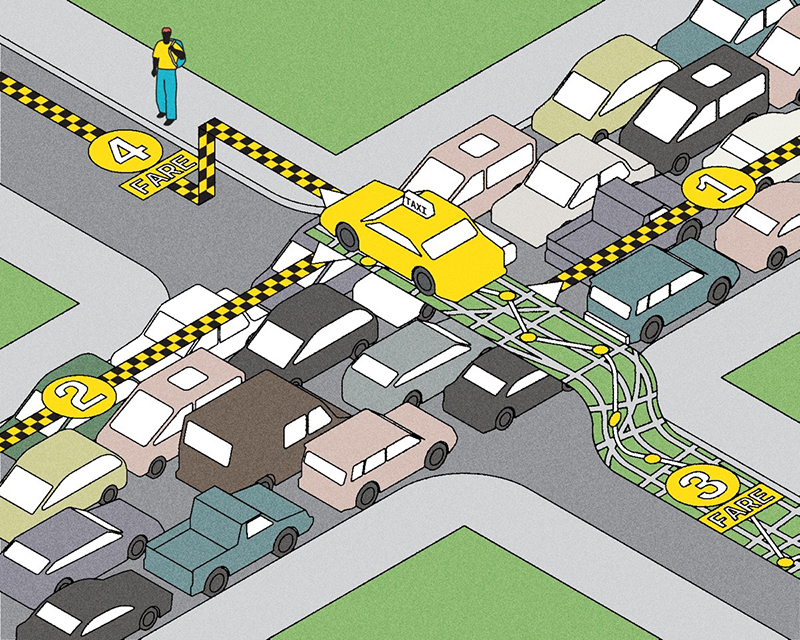It’s a common fear: powerful new AI tools will replace a large part of the labour force (making many people poorer), while enriching the companies that make and deploy AI. But could a different future unfold? Could AI, in fact, help reduce income inequality? Three U of T scholars argue that it could.
In a paper published recently in Science, Rotman School of Management professors Avi Goldfarb, Joshua Gans and Ajay Agrawal explore the question of how AI will play out in the labour market. On the one hand, the thinking goes, AI technology will fully automate some job tasks, allowing companies to lay off workers. But what if, instead, AI helped enable some lower-wage workers to do what formerly only a higher-wage worker could do? “Within the workflow, there are lots of different jobs,” says Goldfarb. If AI were deployed to assist with a complex task that only someone with specialized expertise could do, it might be possible to delegate that task to someone with less expertise. “That empowers less-trained people to do more,” he says.
By taking advantage of the new AI tools, the scholars argue, these lower-wage workers may be able to “upskill” and potentially command higher salaries.
To illustrate their argument, the authors look at the potential impact of AI tools such as ChatGPT on three types of jobs – taxi drivers, reporters and physicians. The authors also explore how AI may affect income distribution in those fields as the technology comes into broader use.
For example, the researchers discuss a new software tool for cab drivers – AI Navi – that can predict areas and times of high traffic, enabling drivers to target these windows to improve response times. They cite a study of the platform, which showed that drivers in Tokyo cut their empty-cab times by seven per cent. It also noted that less experienced drivers benefited the most, increasing their overall job performance by 14 per cent. Similar results, they point out, have been found in other contexts. For example, the use of a generative AI assistant in a call centre substantially improved the productivity of novice and low-skilled workers but had little impact on the most productive workers.
With reporters, Gans, Goldfarb and Agrawal observe that journalists sometimes pitch stories to their editors or take assignments. If editors use AI to generate articles on basic topics, this practice could lead to journalists being undervalued. But, they argue, if journalists seeking to sell ideas to editors use AI to assist with research or set up interviews, then AI may improve overall productivity.
As for physicians, Goldfarb points out that the diagnostic process is inherently predictive, making AI tools well suited to assist. With more straightforward patient conditions, he says, diagnostic AI platforms could be made available to nurse practitioners or pharmacists as a means of broadening the base of health-care workers who can participate in patient diagnosis. This would improve the productivity of the health-care system, while potentially raising the pay of nurses and pharmacists. “The essence of reducing inequality within a profession and within an industry [is that AI] is super-powering people who historically have not been at the top of the income distribution,” Goldfarb says.
Looking at the bigger picture, Gans says there is good reason to assume that the advent of AI tools – as with previous generations of productivity-enhancing technologies, such as word processing and accounting software – will lead to new forms of cognitive work as repetitive tasks are automated.
Case in point: accountants no longer need to spend time doing calculations on paper spreadsheets and can instead use their skills to provide financial advice to clients. The benefits accrue to entrepreneurs, as well. According to one study cited in the paper, small businesses that applied AI translation tools to their e-commerce functions saw their international revenues jump by 17 per cent.
None of this will happen in a regulatory vacuum, of course. From rules governing the use of AI in health care to legislation around privacy, the adoption of these technologies will require guardrails that ensure they don’t produce unmanageable social risk, the authors acknowledge in their Science paper. Yet, as Goldfarb adds, “It isn’t clear that there is a market failure of too little adoption, so I’m hesitant to recommend policies that accelerate adoption.” He says policies designed to clarify the rules without slowing down advances in the technology are useful. Canada’s proposed AI and Data Act, he says, “does a great job clarifying rules around human responsibility for AI systems.”
For policymakers grappling with the existential issue of whether AI will negatively affect part of the labour force, the researchers’ takeaway is that the applications – and, in particular, the way AI platforms can automate parts of existing jobs could boost productivity and lead to an encouraging form of wealth redistribution and upskilling – as opposed to the oft-predicted employment Armageddon.
“It is quite plausible that the use of AI to automate tasks will both increase productivity and decrease income inequality,” they conclude. “If so, then we may want more automation, not less.”
This article was published as part of our series on AI. For more stories, please visit AI Everywhere.







No Responses to “ People Worry That AI Will Replace Workers. But It Could Make Some More Productive ”
We are the most "productive" we've ever been as a society and yet income inequality has not improved even remotely. Why should we assume further gains in "productivity" (read profitability for the company per hour worked) trickle back to us lowly workers?
J’aime cette initiative.